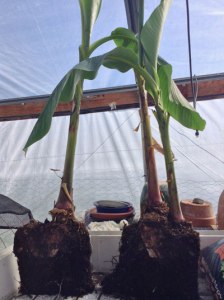Time flies like an arrow, but fruit flies like a banana, and before you know it there are Fungus Gnats attacking your bananas. While futzing about in the greenhouse, immersed in the beginning of a winter cleaning, we discovered a Fungus Gnat infestation on our beloved banana plants. They hadn’t been looking their best. Almost all of the banana leaves were brown and wilted, on some only stumps remained. Although our cool falls will do this to these bananas, it was now time for an intervention.
A rotting stump is the major cause of an infestation, as well as the moistness of the soil. We are officially transitioning into a winter water schedule. Many of our high-priority watering duties will be minimized, and we can rely on mother Nature to take a little more care of us through the winter holidays. This means that our banana plants, in particular, do not need to be watered as frequently, especially since a moist environment creates the perfect home for Fungus Gnats.
The gnat itself is relatively harmless, except for the eggs it lays, but it is an irritating nuisance above all other nuisances. The gnat maggot or larva (remember that egg) feeds on roots in the moist soil as well as on rotting plant material. While the hovering gnats are a serious aesthetic issue, these larva are devastating. And the damage can sneak up on you. We follow a simple IPM-Integrated Pest Management schedule to end a Fungus Gnat infestation.
1) Immediately inspect each plant, cleaning up the soil environment
– Remove all weeds
– Remove decayed stumps, roots, or plant matter rotting in the soil
– In certain situations this meant taking a saw from the workshop, and sawing the plant in half to separate the rotted stump from the other tree in the pot.

2) Trim off any dead or unhealthy leaf
– Yes, the plant will look ugly. Get over it, and so will the plant. Think of it as a bad hair cut, it will grow back!
3) Water with Gnatrol (bacillus thuringiensis – a bacteria that attacks the eggs and larva of the fungus gnats)
4) Set out yellow sticky traps to capture existing Fungus Gnats
– Wear gloves, otherwise your fingers will stick for a week
Avoiding overwatering is important because the pests thrive in the moist environment. However, there is a delicate balance to strike between starving out the Fungus Gnat, and starving out the plant. A good trick, which we use quite frequently, is watering from the bottom up by using water pans beneath the pot. This way the moisture on top dries forces the gnats down into gnatrol-moistened soil below.
Repotting might also improve plant vitality, especially if you utilize virgin soil. A bark-soil will retain less water than a potting soil with peat moss. If you are going to this much trouble to rid yourself of Fungus Gnats, you might also consider using decoy or trap pots filled with sprouting grain. Females will lay their eggs in these pots, rather than your precious plant.

Banana Plants ready to repot after being cleaned
Our banana collection has been dwindling, and we are struggling to keep them looking pretty. The irony is that our bananas don’t even produce fruit; we keep them for their – now nonexistent – leafy looks. With a close eye on our crop, we hope they make it through the winter. We’re looking forward to posting pictures when they perk up this spring.
Here’s to Healthy Banana Trees
–Brielle, Ranch hand at Milewide Nursery

